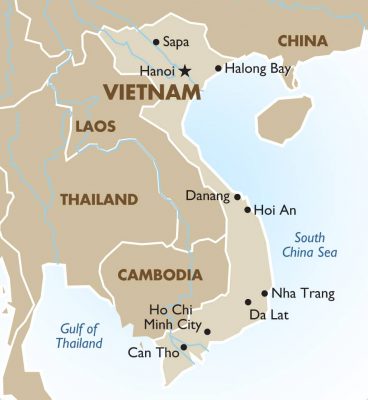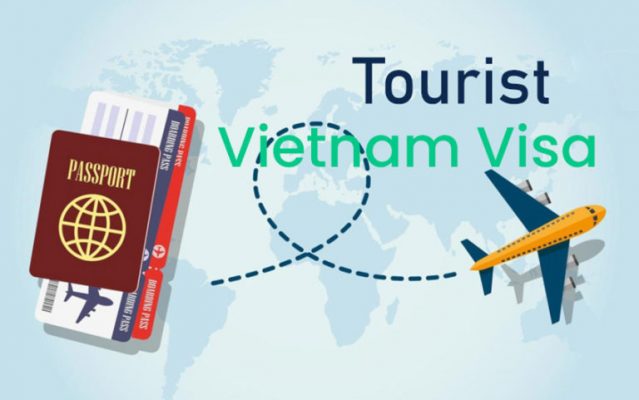Discover the VIETNAM TRAVEL GUIDE FOR FIRST-TIMERS. Your first trip will be a life-changing experience. Cuisine, culture, geography, and scents blend seamlessly. It’s like another world, a fascinating one that will draw you into unexpected journeys, and you’ll never want to leave this beautiful S-shaped land. Ula Travel is happy to provide you with the necessary guidance to start your wonderful trip.
1. The Geography

Geographic map
The geographical structure of Vietnam—the S-shaped land—is extremely diverse and rich. Vietnam is close to Southeast Asia’s center, at the easternmost tip of the Indochinese Peninsula. It borders China to the north, Laos and Cambodia to the west, and the East Sea to the east and south. Our coastal areas are adjacent to those of China, Cambodia, the Philippines, Malaysia, Brunei, Indonesia, and Thailand.
Vietnam is a tropical country, with the majority of its terrain being hills and mountains (occupying three-quarters of the territory), predominantly low mountains, while plains only account for a quarter of the land area.
Areas with elevations lower than 1,000 meters above sea level cover 85% of the territory. Regions with elevations over 2,000 meters above sea level account for only 1%. The hills and mountain ranges form a large arc, stretching 1,400 km from northwest to southeast, facing the East Sea.
Karst terrain is quite common; this terrain is formed by the transportation of water within rocks, leading to chemical reactions. Some tourist destinations with karst terrain include Phong Nha Cave in the Trang An scenic complex, Ninh Binh, and many others.
With its unique geography, Vietnam has created numerous scenic spots for tourists to admire, including the most mysterious caves like Son Doong Cave, challenging routes waiting to be explored like the Ha Giang Loop, and iconic wonders of the world like Ha Long Bay and the Dong Van Karst Plateau. Additionally, Vietnam’s geographical location offers some of the most beautiful beaches on the planet, such as those in Nha Trang, Da Nang, and Phu Quoc.
2. Climate
Vietnam’s climate varies seasonally and regionally, from low to high, from north to south, and from east to west. Due to the strong impact of the northeast monsoon, Vietnam’s average temperature is lower than that of many other countries at the same latitude in Asia.
There are two major climate zones:
- Northern Vietnam (northward from the Hai Van Pass): experiences a tropical monsoon climate with four distinct seasons (spring, summer, autumn, and winter) influenced by the Northeast Monsoon (from the Asian continent) and the Southwest Monsoon (blowing through Thailand, Laos, and the East Sea), with high humidity.
- Southern Vietnam (southward from the Hai Van Pass): due to less influence from the monsoon, the climate is relatively moderately tropical, hot all year round, and divided into two distinct seasons (dry season and rainy season).
Additionally, due to the diverse terrain, Vietnam also has microclimates. Some areas have temperate climates, such as Sapa in Lao Cai province and Da Lat in Lam Dong province; some areas belong to continental climates, like Lai Chau and Son La. These are ideal destinations for tourism and relaxation.
The average temperature ranges from 21°C to 27°C and increases gradually from north to south. In summer, the average temperature across the country is 25°C (Hanoi 23°C, Hue 25°C, and Ho Chi Minh City 26°C). In winter in the northern region, the lowest temperatures occur in December and January. In mountainous areas in the north, such as Sapa, Tam Dao, and Hoang Lien Son, temperatures can drop to 0°C, with snowfall occurring.
3. Transportation

Transportation in Vietnam
The first impression of Vietnam’s transportation for most foreign tourists is chaos and noise. You might experience a cultural shock when participating in traffic. It seems like everyone on the road follows no rule at all, with too many personal vehicles and unpredictable maneuvers. The vehicles move swiftly and unpredictably, which poses challenges for tourists joining the traffic here. However, this also creates an interesting challenge for tourists to conquer.
Participating in traffic also gives foreign tourists some tips for crossing Vietnamese streets: Forget all standard rules when crossing the road in Vietnam; instead, look at the direction of the vehicles rushing towards you and confidently cross the road because no one will hit you. Move slowly and steadily. Foreigners often feel that crossing the road is like playing an adventurous game, but it’s relatively easy to accomplish.
Read more: Traffic in Vietnam – Shocking Facts You Must Know
4. Religion
Vietnam is a multi-religious and multi-faith country. Vietnamese people have a long-standing tradition of religious activities and beliefs. Each ethnic group within the Vietnamese community has its own beliefs closely tied to its economic and spiritual life.
The most populous religions include Buddhism with approximately over 14 million followers, Catholicism with around 7 million followers, Hoa Hao Buddhism with about 1.5 million followers, Protestantism with approximately 1.21 million followers, and Caodaism with over 1.1 million followers.
Additionally, there are other religions, such as Islam, Pure Land Buddhism, the Four Debts of Gratitude, Ba La Mon, Buu Son Ky Huong, Minh Su Dao, Minh Ly Dao, etc.
5. Ethnic Groups

The Beauty of Vietnam’s Ethnic Minorities
With 54 ethnic groups coexisting in a relatively small land area, Vietnam is one of the most ethnically diverse countries in the world.
Currently, only 7 ethnic groups have populations exceeding one million people, including the Kinh, Tay, Thai, Hmong, Muong, Nung, and Khmer, while there are 12 ethnic groups with populations under 10,000 people and 5 ethnic groups with populations under 1,000 people, such as Brau, O Du, Romam, Si La, and Pu Peo.
The Kinh ethnic group constitutes the majority, accounting for approximately 85.4% of Vietnam’s population. The remaining 53 ethnic groups are considered minorities, making up about 14.6% of the country’s population (14,119,256 people).
Regardless of their population size, each ethnic group has its own voice and customs, creating a diverse cultural landscape. Beyond the 54 ethnic groups, many have local branches, exhibiting differences in language, attire, and customs, further enriching the cultural tapestry.
Learn more about: Discover a Round of Vietnam from South to North in 12 Days
6. Languages
The official language used is Vietnamese. Vietnamese is the mother tongue of about 85% of Vietnam’s population, and over three million Vietnamese people live and work abroad. Additionally, Vietnamese is the second language of ethnic minorities in Vietnam.
English is the most common foreign language in this country. Other foreign languages relatively common today include Japanese and Chinese (usually referring to standard Mandarin), while Cantonese is considered the language of ethnic Chinese, similar to Khmer for Khmer people.
7. Currency Unit
The currency of the Socialist Republic of Vietnam is the “dong,” with the national symbol being “đ” and the international symbol being “VND.”
1 USD is equivalent to 25,000 VND.
8. Phone Numbers
- Country code: +84
- Police: 113
- Fire Department: 114
- Medical Emergency: 115
- General Information: 1080
9. Vietnam E- Visa

Visa to Vietnam
According to the regulations of the Law amending and supplementing some articles of the Law on Entry, Exit, Transit, and Residence of Foreigners in Vietnam, as of August 15, 2023, Vietnam will implement new policies and regulations regarding tourist visas and entry-exit procedures for foreigners visiting for tourism purposes.
- Implementation of the Vietnam E-visa for citizens of all countries and territories worldwide without distinction of nationality or country.
- Extension of the electronic visa validity period from 30 days to 3 months (not exceeding 90 days), valid for single or multiple entries.
- Extension of the visa-free entry period for foreign tourists from 15 days as before to 45 days as per the current regulations.
Conditions for entry into Vietnam for tourism purposes:
- Passport validity of at least 6 months.
- Not subject to entry prohibition or restriction into Vietnam.
Are you looking for: Tour Across Vietnam
10. Internet
While internet usage in some countries around the world incurs relatively high fees, in Vietnam, the internet is available almost everywhere. In major cities or tourist destinations, the internet, or wifi, can often be used without charge. You can enter any café and simply order a $1 drink to enjoy free wifi until you leave. Especially notable is the high speed of the internet, which may surprise you.
11. Vietnamese Cuisine

Vietnamese Cuisine
Vietnamese cuisine consistently ranks among the most renowned in the world, with unforgettable dishes. When visiting this beautiful country, you cannot miss experiencing street food, which is a unique and exciting aspect of the culture for any traveler.
What’s special is that the most famous Vietnamese specialties originate from street food. With just $10, you can indulge in street food exploration all day long, sampling renowned specialties such as Pho, Banh Mi, Bun Cha, etc. Each region has its own unique specialties, contributing to the diversity and richness of Vietnamese cuisine.
Read more: Best Vietnamese Street Food – Top Picks for Foodies
12. Vietnam Public holidays
- Liberation Day/Fall of Saigon: April 30th International
- Labor Day: May 1st
- National Day: September 2nd
- Lunar New Year: 1st day of the 1st lunar month
- Hung Kings’ Commemoration Day: 10th day of the 3rd lunar month
Read more: Discover 5 Public Holidays in Vietnam
13. How to Get to Vietnam
The number of international flights to Vietnam has steadily increased recently, a clear indication that the country is becoming increasingly famous as a tourist destination. Most tourists fly to Ho Chi Minh City and Hanoi, although a large number still opt for cheaper indirect flights via Bangkok, Singapore, or Hong Kong. If you’re coming from one of Vietnam’s neighboring countries, you may fly from several cities, taking advantage of the budget flights available from low-cost airlines.
Do not miss: Experience the Endless Beauty of Vietnam in 12 Days
14. Vietnam Daily Travel Costs
You can refer to the budget for 1 person per day below:
For a backpacker budget, the estimated total for a day of travel is 800,000 VND (about 30 USD).
- Accommodation: 300,000 VND/person/day
- Food: 200,000 VND/person/day (street food)
- Transportation: 120,000 VND/person/day
- Attractions: 120,000 VND/person/day
- Drinks: 60,000 VND/person/day
For a mid-range budget, the estimated total for a day of travel is 1,600,000 VND (about 65 USD).
- Accommodation: 600,000 VND/person/day (3-star hotel)
- Food: 350,000 VND/person/day (street food and some local restaurants)
- Transportation: 250,000 VND/person/day
- Attractions: 250,000 VND/person/day
- Drinks: 150,000 VND/person/day
For a high-end budget, the estimated total for a day of travel is 3,150,000 VND (about 126 USD).
- Accommodation: 1,500,000 VND/person/day (luxury hotel)
- Food: 500,000 VND/person/day
- Transportation: 300,000 VND/person/day
- Attractions: 600,000 VND/person/day
- Drinks: 250,000 VND/person/day
You will be like: Vietnam Tour Package 14 Days
15. Get Around Vietnam with Vietnam Travel Guide
Public transit: Safe and dependable public transportation is available in Vietnam’s larger cities, including Hanoi and Ho Chi Minh City. Buses travel through most of Hanoi and typically stop close to many of the main tourist attractions. Depending on the distance traveled, bus tickets typically cost between 7,000 VND and 15,000 VND and are purchased in cash. In addition, there is a sizable bus system in Ho Chi Minh City. Ticket prices range up to 10,000 VND, depending on the distance traveled.
Cyclo is a quite expensive mode of transportation. A quick ride can cost as little as 50,000 VND, but a nighttime ride can cost as much as 40,000 VND. The most well-liked choice is the xe om (grab, uber, go jerk), a motorbike taxi with rates beginning at 15,000 VND. But you’ll need to hang on tight (and wear a helmet, because these things happen).
Train: Although certain trains may be slow, traveling by train is a popular choice for travelers since it’s inexpensive, safe, and comfortable, and it offers some breathtaking views of the country’s landscapes. You may go almost anywhere in the nation (apart from the Central Highlands and the Mekong Delta) because to the rail network, which spans the majority of the nation.
- The cost of a comfortable seat (not a berth) on a train traveling from Ho Chi Minh City to Hanoi, which is the length of the nation, starts at 1,000,000 VND. It is a three-day journey.
- The trip from Hanoi to Hue takes around 13 hours and costs about 600,000 VND, while the trip from Ho Chi Minh City to Nha Trang takes about 8 hours and costs about 500,000 VND.
Bus: Long-distance hop-on/hop-off bus tours covering the entirety of Vietnam are easily accessible. At any point along the route, you can get on or off. Although they cater to tourists, because this service is so reasonably priced, locals also use it. Although prices vary by operator and route, the average cost from Hanoi to Ho Chi Minh City is between 815,000 VND and 1,600,000 VND.

Vietnam Airlines is a domestic airline with the best quality
Domestic flights: If you want to pack as much as possible into a shorter trip, it’s a smart idea to fly domestically in Vietnam. For instance, it takes two hours to fly from Hanoi to Ho Chi Minh City, while it would take at least thirty hours to travel by train. The starting price for domestic one-way flights is approximately 590,000 VND.
Individual transfers: Since foreign visitors are not allowed to drive themselves, private transportation in Vietnam provide tourists with freedom and convenience. Whether for travel to and from the airport or touring various locations, renting a car with a driver enables convenient and hassle-free transportation.
Additionally, private transfers can be tailored to include stops along the way, allowing you to design your own unique tour or go on a multi-day excursion to explore Vietnam’s varied landscapes.
With the information provided above, hopefully you’ll have a comprehensive toolkit for your exploration of Vietnam. Feel free to contact us if you need any guidance or advice. Ula Travel is always ready and honored to be a part of your journey to discover Vietnam.
See more: Vietnam overview
























